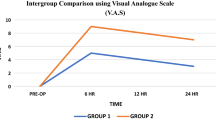Abstract
In previous studies, it was shown that the post-tonsillectomy wound infiltration of bupivacaine can reduce postoperative pain. The objective of this study is to determine whether the postoperative wound infiltration with a mixture of bupivacaine, mepivacaine and adrenaline is more effective than the sole application of bupivacaine. A prospective, double-blind, randomized, control study included 30 patients scheduled for “cold steel” tonsillectomy. All patients obtained post-tonsillectomy infiltration of 6.25 mg bupivacaine alone on one side and 3.75 mg bupivacaine, 25 mg mepivacaine and 0.0125 mg epinephrine on the other side (intra-individual study design). Intake of analgesics and postoperative pain was assessed 0–6 days after surgery by visual analogue scale in inactivity and during swallowing by the nurse staff. Bleeding, dysphagia, pain, aspiration or extraordinary pain sensation were registered by the patient. The pain scores did not differ between the groups. All patients received systemic painkillers; 6 (20%) patients needed intravenous analgesics. Postoperative haemorrhage occurred in two patients without correlation to a certain local anaesthetic. Two patients developed sinus tachycardia for 2.5 min after epinephrine infiltration. Because of cost-effectiveness and complication rates, we recommend only post-tonsillectomy wound infiltration of bupivacaine. The injection should be placed in superficial muscle and connective tissue. A stringent systemic analgesia regime is indispensable for pain relief after tonsillectomy.





Similar content being viewed by others
References
Dal D, Celebi N, Elvan EG, Celiker V, Aypar U (2007) The efficacy of intravenous or peritonsillar infiltration of ketamine for postoperative pain relief in children following adenotonsillectomy. Paediatr Anaesth 17(3):263–269
Freeman SB, Markwell JK (1992) Sucralfate in alleviating post-tonsillectomy pain. Laryngoscope 102(11):1242–1246
Goldsher M, Podoshin L, Fradis M et al (1996) Effects of peritonsillar infiltration on post-tonsillectomy pain. A double-blind study. Ann Otol Rhinol Laryngol 105(11):868–870
Nordahl SH, Albrektsen G, Guttormsen AB, Pedersen IL, Breidablikk HJ (1999) Effect of bupivacaine on pain after tonsillectomy: a randomized clinical trial. Acta Otolaryngol 119(3):369–376
Orntoft S, Longreen A, Moiniche S, Dhal JB (1994) A comparison of pre- and postoperative tonsillar infiltration with bupivacaine on pain after tonsillectomy. A pre-emptive effect? Anaesthesia 49(2):151–154
Johansen M, Harbo G, Illum P (1996) Preincisional infiltration with bupivacaine in tonsillectomy. Arch Otolaryngol Head Neck Surg 122(3):261–263
Knudsen KE, Brofeldt S, Mikkelsen S, Bille M, Brennum J, Dahl JB (1995) Peritonsillar infiltration with low-dose tenoxicam after tonsillectomy. Br J Anaesth 75(3):286–288
Jebeles JA, Reilly JS, Gutierrez JF, Bradley EL Jr, Kissin I (1991) The effect of pre-incisional infiltration of tonsils with bupivacaine on the pain following tonsillectomy under general anesthesia. Pain 47(3):305–308
Hollis LJ, Burton MJ, Millar JM (2000) Perioperative local anaesthesia for reducing pain following tonsillectomy. Cochrane Database Syst Rev (2):CD001874
Grainger J, Saravanappa N (2008) Local anaesthetic for post-tonsillectomy pain: a systematic review and meta-analysis. Clin Otolaryngol 33(5):411–419
Sorensen WT, Wagner N, Aarup AT, Bonding P (2003) Beneficial effect of low-dose peritonsillar injection of lidocaine-adrenaline before tonsillectomy. A placebo-controlled clinical trial. Auris Nasus Larynx 30(2):159–162
Stelter K, Hempel JM, Berghaus A, Andratschke M, Luebbers CW, Hagedorn H (2009) Application methods of local anaesthetic infiltrations for postoperative pain relief in tonsillectomy: a prospective, randomised, double-blind, clinical trial. Eur Arch Otorhinolaryngol 266(10):1615–1620
Nolte H, Puente-Egido JJ (1969) The new local anesthetic bupivacaine (carbostesin) in clinical use. Anaesthesist 18(8):264–265
Arikan OK, Ozcan S, Kazkayasi M, Akpinar S, Koc C (2006) Preincisional infiltration of tonsils with ropivacaine in post-tonsillectomy pain relief: double-blind, randomized, placebo-controlled intraindividual study. J Otolaryngol 35(3):167–172
Holt GR, Watkins TM, Yoder MG, Garcia A (1981) The effect of tonsillectomy on impedance audiometry. Otolaryngol Head Neck Surg 89(1):20–26
Warnock FF, Lander J (1998) Pain progression, intensity and outcomes following tonsillectomy. Pain 75(1):37–45
Williamson A, Hoggart B (2005) Pain: a review of three commonly used pain rating scales. J Clin Nurs 14(7):798–804
Finley GA, McGrath PJ (1996) Postoperative pain in children. Can J Anaesth 43(4):418–419
Sloman R, Wruble AW, Rosen G, Rom M (2006) Determination of clinically meaningful levels of pain reduction in patients experiencing acute postoperative pain. Pain Manag Nurs 7(4):153–158
Pasero C, McCaffery M (2005) No self-report means no pain-intensity rating. Am J Nurs 105(10):50–53
Somdas MA, Senturk M, Ketenci I, Erkorkmaz U, Unlu Y (2004) Efficacy of bupivacaine for post-tonsillectomy pain: a study with the intra-individual design. Int J Pediatr Otorhinolaryngol 68(11):1391–1395
Hultcrantz E, Linder A, Markstrom A (2005) Long-term effects of intracapsular partial tonsillectomy (tonsillotomy) compared with full tonsillectomy. Int J Pediatr Otorhinolaryngol 69(4):463–469
Noordzij JP, Affleck BD (2006) Coblation versus unipolar electrocautery tonsillectomy: a prospective, randomized, single-blind study in adult patients. Laryngoscope 116(8):1303–1309
Kujawski O, Dulguerov P, Gysin C, Lehmann W (1997) Microscopic tonsillectomy: a double-blind randomized trial. Otolaryngol Head Neck Surg 117(6):641–647
Haddow K, Montague ML, Hussain SS (2006) Post-tonsillectomy haemorrhage: a prospective, randomized, controlled clinical trial of cold dissection versus bipolar diathermy dissection. J Laryngol Otol 120(6):450–454
Klug TE, Ovesen T (2006) Post-tonsillectomy hemorrhage: incidence and risk factors. Ugeskr Laeger 168(26–32):2559–2562
Malamed SF (2000) New anesthetics. Rev Belge Med Dent 55(1):9–18
Woolf CJ, Shortland P, Coggeshall RE (1992) Peripheral nerve injury triggers central sprouting of myelinated afferents. Nature 355(6355):75–78
Puente-Egido JJ, Dudeck J, Nolte H (1967) The clinical use of the local anesthetic marcain (Carbostesin). Anaesthesist 16(8):224–226
Rasgon BM, Cruz RM, Hilsinger RL Jr et al (1991) Infiltration of epinephrine in tonsillectomy: a randomized, prospective, double-blind study. Laryngoscope 101(2):114–118
Binning R, Watson WR, Samrah M, Martin E (1962) Premedication for adenotonsillectomy. Br J Anaesth 34:812–816
Windfuhr JP (2008) Steroids for reduction of morbidity following tonsillectomy. HNO 56(1):43–53
Conflict of interest statement
None of the authors has a financial relationship to an organization mentioned in this study. For this study no sponsoring by third parties was needed.
Author information
Authors and Affiliations
Corresponding author
Rights and permissions
About this article
Cite this article
Stelter, K., Hiller, J., Hempel, J.M. et al. Comparison of two different local anaesthetic infiltrations for postoperative pain relief in tonsillectomy: a prospective, randomised, double blind, clinical trial. Eur Arch Otorhinolaryngol 267, 1129–1134 (2010). https://doi.org/10.1007/s00405-009-1200-8
Received:
Accepted:
Published:
Issue Date:
DOI: https://doi.org/10.1007/s00405-009-1200-8




